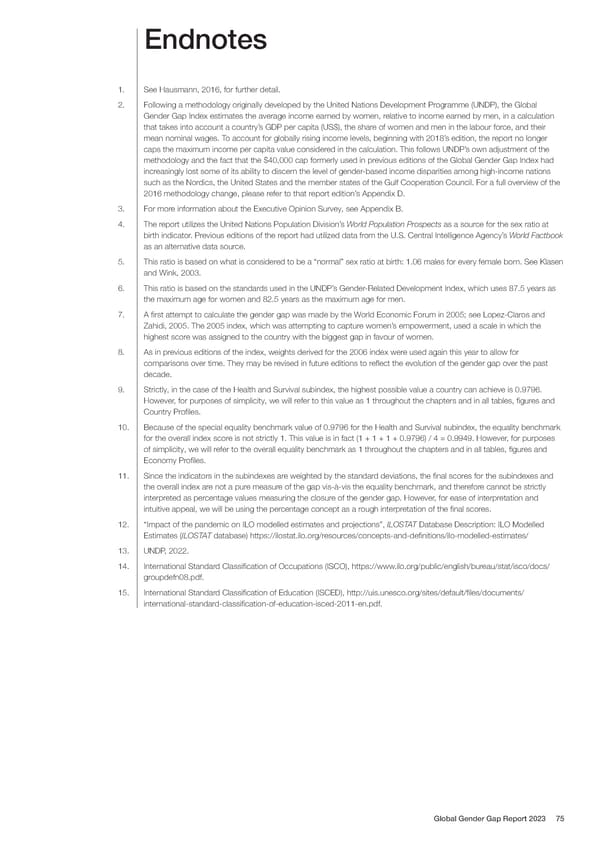Endnotes 1. See Hausmann, 2016, for further detail. 2. Following a methodology originally developed by the United Nations Development Programme (UNDP), the Global Gender Gap Index estimates the average income earned by women, relative to income earned by men, in a calculation that takes into account a country’s GDP per capita (US$), the share of women and men in the labour force, and their mean nominal wages. To account for globally rising income levels, beginning with 2018’s edition, the report no longer caps the maximum income per capita value considered in the calculation. This follows UNDP’s own adjustment of the methodology and the fact that the $40,000 cap formerly used in previous editions of the Global Gender Gap Index had increasingly lost some of its ability to discern the level of gender-based income disparities among high-income nations such as the Nordics, the United States and the member states of the Gulf Cooperation Council. For a full overview of the 2016 methodology change, please refer to that report edition’s Appendix D. 3. For more information about the Executive Opinion Survey, see Appendix B. 4. The report utilizes the United Nations Population Division’s World Population Prospects as a source for the sex ratio at birth indicator. Previous editions of the report had utilized data from the U.S. Central Intelligence Agency’s World Factbook as an alternative data source. 5. This ratio is based on what is considered to be a “normal” sex ratio at birth: 1.06 males for every female born. See Klasen and Wink, 2003. 6. This ratio is based on the standards used in the UNDP’s Gender-Related Development Index, which uses 87.5 years as the maximum age for women and 82.5 years as the maximum age for men. 7. A 昀椀rst attempt to calculate the gender gap was made by the World Economic Forum in 2005; see Lopez-Claros and Zahidi, 2005. The 2005 index, which was attempting to capture women’s empowerment, used a scale in which the highest score was assigned to the country with the biggest gap in favour of women. 8. As in previous editions of the index, weights derived for the 2006 index were used again this year to allow for comparisons over time. They may be revised in future editions to re昀氀ect the evolution of the gender gap over the past decade. 9. Strictly, in the case of the Health and Survival subindex, the highest possible value a country can achieve is 0.9796. However, for purposes of simplicity, we will refer to this value as 1 throughout the chapters and in all tables, 昀椀gures and Country Pro昀椀les. 10. Because of the special equality benchmark value of 0.9796 for the Health and Survival subindex, the equality benchmark for the overall index score is not strictly 1. This value is in fact (1 + 1 + 1 + 0.9796) / 4 = 0.9949. However, for purposes of simplicity, we will refer to the overall equality benchmark as 1 throughout the chapters and in all tables, 昀椀gures and Economy Pro昀椀les. 11. Since the indicators in the subindexes are weighted by the standard deviations, the 昀椀nal scores for the subindexes and the overall index are not a pure measure of the gap vis-à-vis the equality benchmark, and therefore cannot be strictly interpreted as percentage values measuring the closure of the gender gap. However, for ease of interpretation and intuitive appeal, we will be using the percentage concept as a rough interpretation of the 昀椀nal scores. 12. “Impact of the pandemic on ILO modelled estimates and projections”, ILOSTAT Database Description: ILO Modelled Estimates (ILOSTAT database) https://ilostat.ilo.org/resources/concepts-and-de昀椀nitions/ilo-modelled-estimates/ 13. UNDP, 2022. 14. International Standard Classi昀椀cation of Occupations (ISCO), https://www.ilo.org/public/english/bureau/stat/isco/docs/ groupdefn08.pdf. 15. International Standard Classi昀椀cation of Education (ISCED), http://uis.unesco.org/sites/default/昀椀les/documents/ international-standard-classi昀椀cation-of-education-isced-2011-en.pdf. Global Gender Gap Report 2023 75
 Global Gender Gap Report 2023 Page 74 Page 76
Global Gender Gap Report 2023 Page 74 Page 76